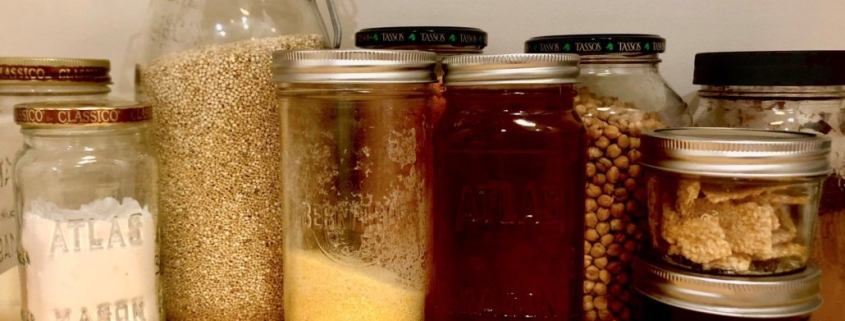
Go Zero Waste (or close to it)!
There are many ways we can reduce our footprint – collectively, we can create a lot of positive change! One fun way is reducing the amount of waste we create. The packaging that everyday items and food comes in really takes a toll on the environment: it takes resources to produce, ship around the globe, and to get rid of. All this waste can make its way into our streams, rivers and oceans, degrading them all.

“We don’t need a handful of people doing zero waste perfectly. We need millions of people doing it imperfectly.“
– Anne Marie Bonneau, Zero Waste Chef
We can start by taking inventory of everything we do and use in a day. This process can help us create a list of possible alternatives to try. A visual inventory is even better – pile your trash and recycling for a day to visualize how much we really toss “away” each day.
Sign the pledge and have a contest with your friends to see who can produce the least amount of trash in a month – and even better, who can produce less “recycle waste”. Recyclables still use energy to be processed (maybe it should be renamed to Reduce- Reuse- Refuse!). And we cannot always rely on such services – glass container recycling was temporarily suspended due to flooding in British Columbia.
To help get you started, here is a map of Zero-Waste Shops around the Strait of Georgia!

Food & Drink Tips
A big way we can reduce our waste is by taking a few simple steps when it comes to purchasing food. Shop local farmer’s markets and sign up for a local farm’s CSA (Community Supported Agriculture) subscription boxes. It helps support local farms and eating local also helps reduce your carbon footprint (see more about reducing the impact of what you eat including a map of farmer’s markets). With subscription boxes you can get fresh, local produce delivered to your doorstep in beautiful reusable wooden crates, and they usually come with recipes, too!

Let’s explore some other simple switches we can make to reduce the waste from what we eat and drink.
- Visit Zero Waste Shops in your community (simply bring your washed jars and containers) – you can even get growlers for refill at breweries and kombucha shops.
- Use your own totes and produce bags every time you go to the grocery store
- Bring your own containers to bakeries and the butcher (ditch the single-use containers!)
- Carry a to-go mug in your bag for when you need a caffeine hit and a refillable water bottle when you are thirsty
- Refuse take-out cutlery and carry reusable utensils in your bag
- If you expect left-overs when eating out, bring your own containers and box them up yourself
- When ordering take-out request they pack it in your containers
- Wash the glass jars and reuse them for bulk items like dried beans and spices, or even as drinking glasses
- If you’re a coffee lover – use pour-overs, a stovetop espresso maker or a French press instead of coffee pods and filters (you can add coffee grinds into your garden, plants love them)
- Make your own bees-wax wraps to replace your disposable plastic wrap
- Say no to straws, or purchase reusable ones
- Grow your own food – even in containers on a balcony will do. Check for local seed saving programs and libraries to get started
- Compost your kitchen scraps and garden waste in your backyard or balcony in a container – then use this soil to grow food in the following year, learn more about composting
- Sew/upcycle homemade napkins – it makes meals much more special
- Create your own reusable produce bags, you can even upcycle old clothing

Other Household Tips
We create waste in more ways than when purchasing food – like washing dishes and doing laundry. These typically involve using products that come in packaging. We can learn to make our own and even save money doing so!
- Instead of purchasing new clothing, visit your local thrift shop
- Purchase quality products, clothing, anything and everything that will last longer and can be repaired. Although this may cost more up front, you will save in the end, and mother earth will thank you
- Host clothing and toy swaps, sell on Facebook Marketplace – one person’s trash is another one’s treasure
- Make your own furniture and shelves by upcycling old wood. You can sometimes find off-cuts of wood from your local hardware shop. Get creative!
- Create your own personal care products (e.g., DIY deodorants)
- When doing laundry – skip disposable dryer sheets, use dryer balls instead or nothing at all! If you have the space, and the weather is working with you – hang your laundry on a clothes line. And you can either make your own laundry soap mix or you can purchase laundry powder at your local zero waste shop
- Create your own safe cleaning supplies
- Use cloth diapers for your baby
- Taking advantage of books and magazines from your local library
Other Resources for Going Zero-Waste:
Zero Waste Home – with a starter guide for going waste-free
Trash is for Tossers – with Zero Waste Alternatives- The Ultimate List
How to Go Zero Waste – David Suzuki
Photo credits: Maria Catanzaro
